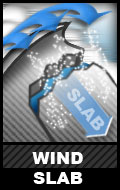Weekend Avalanche Outlook
Heightened avalanche conditions on specific terrain features. Evaluate snow and terrain carefully; identify features of concern. Natural avalanches unlikely; human-triggered avalanches possible. Small avalanches in specific areas; or large avalanches in isolated areas.
Avalanche Problems:
 Strong winds and fresh, moist snow trickling in through the week have led to widespread wind slab development on leeward terrain. Expect possible wind slabs to be D1-D3 in size, stubborn to touchy, and problematic above ~2500′ on primarily SW to N aspects – especially near and along the lee side of ridges and cross-loaded gully sidewalls. In the northern advisory zone (Eagle River areas), wind slabs have proven deadly this week with a presumed canine fatality from a human triggered wind slab off Harp Mountain on Thursday, February 25 (click here to view associated observations). In the southern advisory zone (Front Range – specifically via Canyon Road), folks have been skiing the popular slopes of Peak 2-4 all week and apparently without incident. However, snowpit results from Thursday, February 25 (click here for observations) raised concerns with an easily identifiable wind slab and weak interface ~1′ below the surface that could prove reactive to human triggers. Be on the lookout for red flags and obvious clues like cracking, collapsing or “whumphing,” hollow sounding-feeling snow with a denser slab overlying looser and weaker snow, and recent wind slab avalanches. Pole probing and hand pits are a quick and easy way to track wind slab distribution as you travel.
Strong winds and fresh, moist snow trickling in through the week have led to widespread wind slab development on leeward terrain. Expect possible wind slabs to be D1-D3 in size, stubborn to touchy, and problematic above ~2500′ on primarily SW to N aspects – especially near and along the lee side of ridges and cross-loaded gully sidewalls. In the northern advisory zone (Eagle River areas), wind slabs have proven deadly this week with a presumed canine fatality from a human triggered wind slab off Harp Mountain on Thursday, February 25 (click here to view associated observations). In the southern advisory zone (Front Range – specifically via Canyon Road), folks have been skiing the popular slopes of Peak 2-4 all week and apparently without incident. However, snowpit results from Thursday, February 25 (click here for observations) raised concerns with an easily identifiable wind slab and weak interface ~1′ below the surface that could prove reactive to human triggers. Be on the lookout for red flags and obvious clues like cracking, collapsing or “whumphing,” hollow sounding-feeling snow with a denser slab overlying looser and weaker snow, and recent wind slab avalanches. Pole probing and hand pits are a quick and easy way to track wind slab distribution as you travel.
 Persistent slabs remain a low probability, but very high consequence, concern. Persistent weak layers have been identified on relatively popular slopes across Chugach State Park this weak, generally seeming to be more of a problem in the northern advisory area (Eagle River areas) where the snowpack is thinner and these weak layers are closer to the surface and thus more likely to impacted, and fail, from the weight of a human trigger. In the Front Range, persistent slabs are buried deeper and are generally expected to be unresponsive to human triggers except in isolated areas. Snowpit test results in the Front Range have shown persistent slabs to be unreactive within the standard parameters of tests, but reactive and with propagation propensity when subject to more force. Expect isolated D2-D3, unlikely to possible, unreactive to stubborn persistent slabs above ~3000′ on primarily the typically leeward SW to N aspects. You’ll likely need to dig a full-on snowpit, examine the layers, and conduct compression (CT) and extended column tests (ECT) in suspect areas in order to get a better handle on the persistent slab problem.
Persistent slabs remain a low probability, but very high consequence, concern. Persistent weak layers have been identified on relatively popular slopes across Chugach State Park this weak, generally seeming to be more of a problem in the northern advisory area (Eagle River areas) where the snowpack is thinner and these weak layers are closer to the surface and thus more likely to impacted, and fail, from the weight of a human trigger. In the Front Range, persistent slabs are buried deeper and are generally expected to be unresponsive to human triggers except in isolated areas. Snowpit test results in the Front Range have shown persistent slabs to be unreactive within the standard parameters of tests, but reactive and with propagation propensity when subject to more force. Expect isolated D2-D3, unlikely to possible, unreactive to stubborn persistent slabs above ~3000′ on primarily the typically leeward SW to N aspects. You’ll likely need to dig a full-on snowpit, examine the layers, and conduct compression (CT) and extended column tests (ECT) in suspect areas in order to get a better handle on the persistent slab problem.
All the wind and snow we’ve received in the past week has generally caused significant cornice growth. In some areas, cornices have grown quite large and overhanging. Be careful this weekend as they’ve been observed to be easy to fail this week if subject to the weight of a human. Keep in mind that besides the inherent danger of a cornice fall, the shock to the snowpack caused by the cornice fall can trigger subsequent avalanches. Even on relatively or seemingly benign terrain like a lower-angled gully sidewall, watch for cornices along the lip that could fail causing you to fall into a terrain trap.
If you’re getting out in Chugach State Park this weekend; please share your snow, weather, and avalanches observations! They’re invaluable for improving this forecast-advisory. Email to info@anchorageavalanchecenter.org or submit via the observations form. Thanks!
